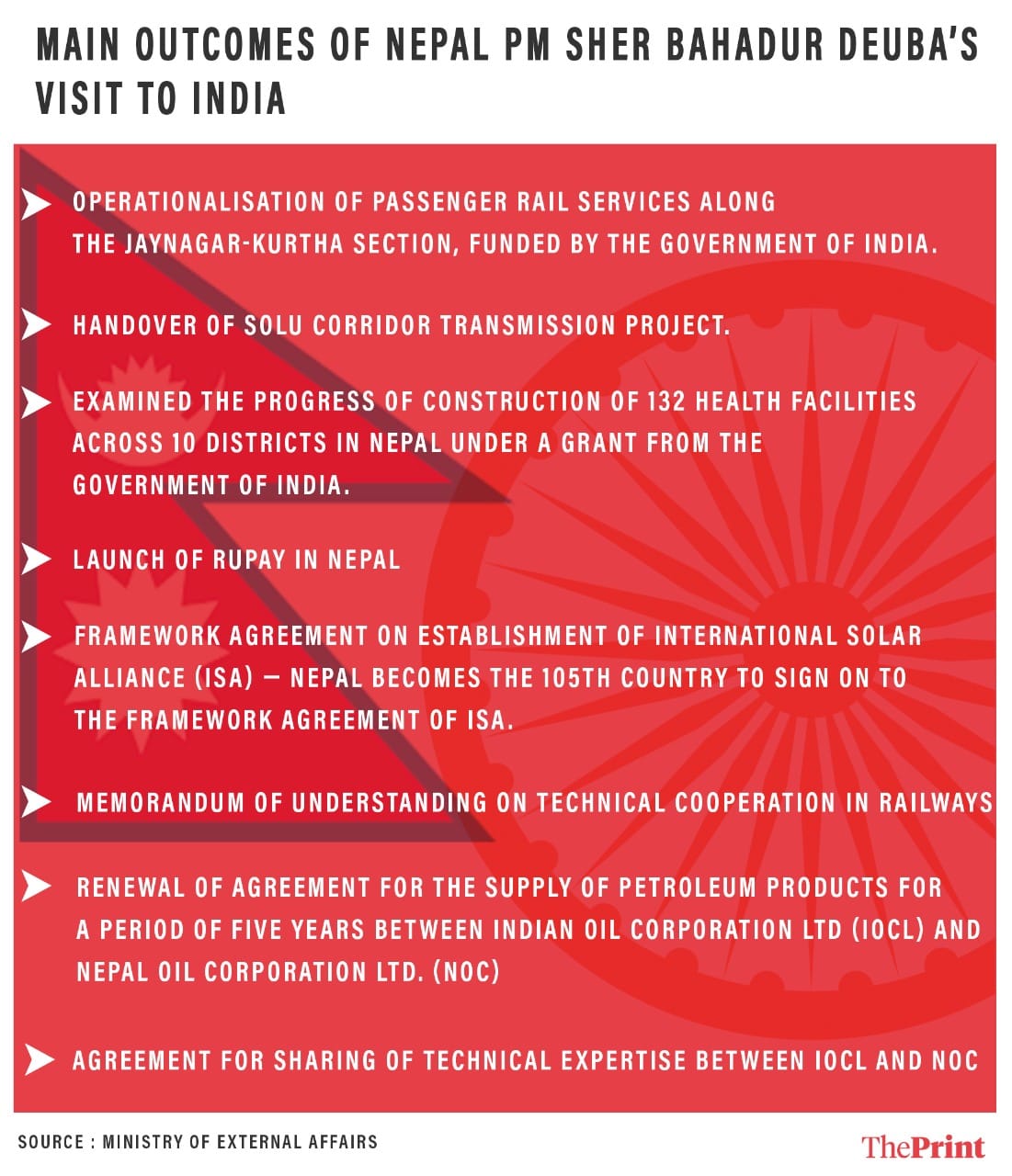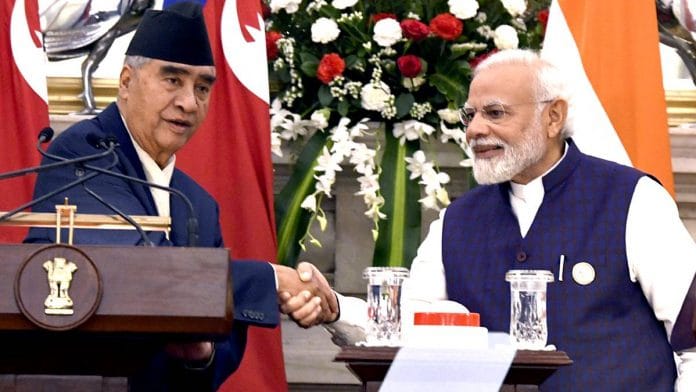New Delhi: Two years after India-Nepal bilateral ties took a major hit with Kathmandu redrawing its boundaries, Prime Minister Narendra Modi and his Nepali counterpart, Sher Bahadur Deuba, made a move towards ironing out differences by announcing a plethora of development projects Saturday.
From cross-border rail connectivity to creating electricity trade corridors, India and Nepal sought to smoothen the relationship, which faces several challenges at the moment, from border issues to a growing Chinese footprint in the Himalayan state.
During the bilateral summit between Modi and Deuba, the two sides launched an India-Nepal Joint Vision Statement on Power Sector Cooperation, which was the biggest takeaway from the Nepal PM’s visit to India, apart from rail connectivity.
“In view of Nepal’s high potential for hydroelectricity generation and export, it is important to have broad understanding in power export cooperation between our two countries. So, cross-border power trade remains a priority agenda during our discussion,” Deuba said during his opening remarks at Hyderabad House before meeting Modi.
He also said, “I am happy with the Nepal-India Joint Vision Statement on Power Sector Cooperation that we have agreed upon today for mutually beneficial cooperation on hydroelectricity generation, transmission and cross-border trade. I welcome Prime Minister Modi ji’s offer of purchasing electricity from Nepal.”
According to the power sector vision document, New Delhi’s recent cross-border electricity trade regulations have enabled Nepal to access the Indian market and trade power with India.
The two prime ministers Saturday also said that India and Nepal have “unprecedented opportunities” in the electricity trade. These include joint development of power generation projects in Nepal, the development of cross-border transmission infrastructure, and bi-directional power trade with appropriate access to electricity markets in both countries, based on mutual benefits.
They also referred to the market demand and applicable domestic regulations of each country, coordinated operation of the national grids, and institutional cooperation in sharing the latest operational information, technology and know-how.
The 90-km-long 132-kilovolt (kV) Solu Corridor transmission line in Nepal, built with an Indian line of credit at a cost of Rs 200 crore, was also inaugurated Saturday.
“We also agreed on the subject of more participation by Indian companies in Nepal’s hydro power development plans. It is a matter of happiness that Nepal is exporting its surplus power to India. It will contribute well to the economic progress of Nepal,” said Modi.
The two prime ministers also jointly launched the operationalisation of a 35-km cross-border rail link from Jaynagar in Bihar to Kurtha in Nepal, which had also become an irritant in India-Nepal ties.
The India-funded project, which involved conversion of the 34.9-km narrow gauge section into broad gauge, was handed over to Nepal in October this year. But the process of operationalising the railway was delayed due to security issues.
Modi and Deuba also launched the operation of RuPay cards in Nepal, intended to help promote the flow of Indian tourists to the Himalayan country.

Also read: Expert raise concern over implementation of latest trade deal between Nepal, China
Nothing concrete on Nepal’s 2020 map
Although the border issue was discussed, no progress was made on the matter, which has the potential to disturb the delicate relationship between India and Nepal once again.
“We discussed the boundary matters and I urged him to resolve them through established mechanisms,” said Deuba in his media statement.
Modi said the issue of “open borders of India and Nepal” was discussed in the wake of it being “misused by unwanted elements.”
“We also stressed on maintaining close cooperation between our defence and security institutions,” he added.
However, India did not officially raise the issue of Nepal changing its political map in 2020 and including in its territory the disputed regions of Kalapani, Lipulekh and Limpiyadhura.
Addressing the media later on, Foreign Secretary Harsh V. Shringla said, “I think there was a sense that we should address it through discussion and dialogue.”
Shringla added, “The two sides had a brief discussion and generally felt that in order to start addressing the issue, we need to have dialogue and discussion in a responsible manner and that’s something we will engage in … And we have no doubt that between the two close and friendly countries, we will find a way.”
While India always acknowledged that it needs to settle the border issues of Kalapani and Susta with Nepal, matters turned serious in November 2019 when the Modi government came out with a new political map of India after the scrapping of Article 370 in Jammu and Kashmir. This depicted Kalapani as part of Uttarakhand.
However, all hell broke loose when Defence Minister Rajnath Singh inaugurated the new road to Kailash Mansarovar on 5 May, 2020. The road connects Pithoragarh in Uttarakhand with the Lipulekh Pass — which Nepal considers as part of its own territory — at the India-China border.
Subsequently, Nepal handed over a diplomatic note to the Indian envoy in Kathmandu, Vinay Mohan Kwatra, on 11 May, 2020, asking India to hold talks at the foreign secretary level virtually; this was rejected by India.
Finally, on 20 May that year, the government, then headed by K.P.S. Oli, released a new map of Nepal, showing the disputed territories of Limpiyadhura, Lipulekh and Kalapani within its borders — which India categorically rejected.
(Edited by Rohan Manoj)
Also read: China encroaching Nepal’s territory along border, says report






